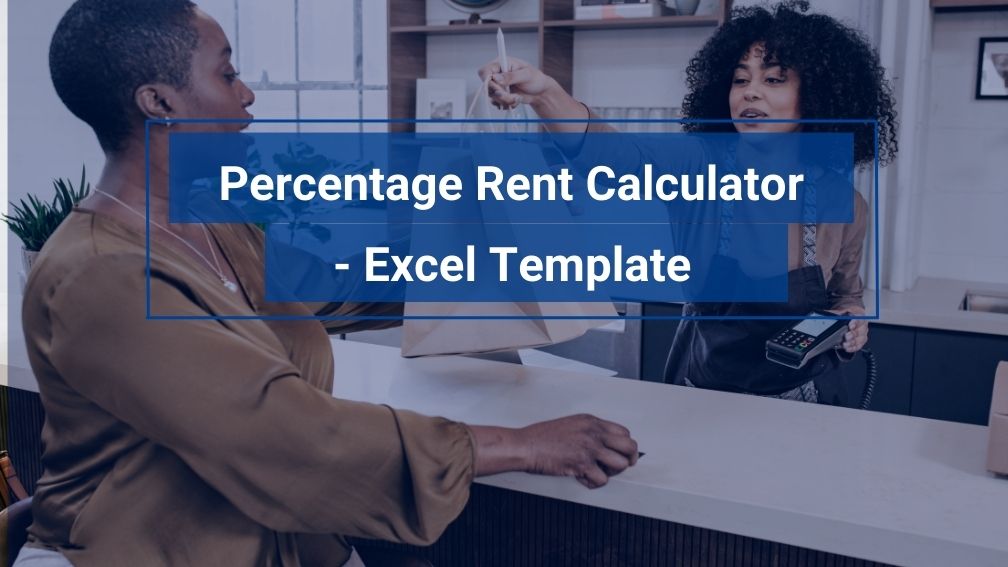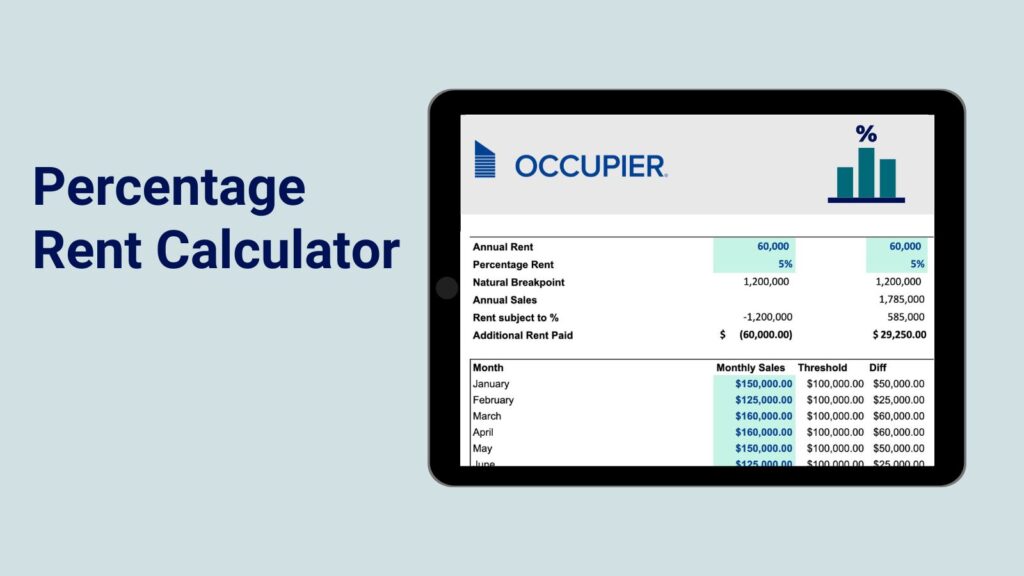Percentage Rent in a Commercial Lease – Excel Calculator
Last Updated on December 13, 2023 by Morgan Beard
When it comes to commercial leases, one of the most common types of rent arrangements is percentage rent. If you are a commercial tenant looking to better understand percentage rent and how it is calculated in your commercial lease? Look no further than our comprehensive guide to the Percentage Rent in a Commercial Lease – Excel Calculator.
We will explore the ins and outs of percentage rent from a commercial tenant’s perspective, including its definition, advantages and disadvantages, and when it’s commonly used. We’ll also provide you with step-by-step instructions on how to use both the percentage rent calculator and Excel calculator, and give you sample calculations to help you understand how they work
Whether you’re a seasoned pro or new to the world of commercial leases, this post will give you the tools you need to confidently navigate percentage rent in your lease agreements. So let’s dive in!
What is Percentage Rent?
Percentage rent is a type of rent arrangement where the tenant pays a base rent or minimum rent plus a percentage of their monthly gross income or on-premise sales to their landlord. For example, a tenant might pay $1,500 per month in base rent plus 5% of their gross sales. This means that if the tenant’s gross sales for the month were $30,000, they would owe an additional $1,500 in percentage rent.
Percentage rent is most commonly used in retail and other commercial spaces in which the tenant’s brick & mortar sales are directly tied to their space usage. Landlords like percentage rent because it incentivizes tenants to make more sales and increase their revenue, which can result in higher rent payments.
Which Commercial Tenants Navigate Percentage Rent?
Percentage rent leases are often utilized in retail leases, where the landlord may require tenants to pay a percentage of their gross sales as rent. While this type of lease is most commonly associated with high-volume businesses like stripe malls or shopping centers, even small businesses looking to capitalize on high foot traffic may be subject to it. The percentage rate applied is typically based on an industry standard of 7% on every dollar of revenue with little room for negotiation. The breakpoint is the percentage rate threshold of gross sales that must be met before the percentage multiplier is applied, resulting in the landlord receiving a portion of the tenant’s income.
While percentage rent may seem daunting to tenants, it can have advantages for both parties. Landlords are motivated to keep tenants in their properties for as long as possible, and percentage rent aligns their interests with those of tenants, as landlords will benefit when tenants’ businesses perform well. For tenants, percentage rent provides an opportunity to pay a lower annual base rent, with the potential to pay more as their sales increase.
Percentage Rent – Excel Calculator
The Advantages & Disadvantages of Percentage Rent:
Percentage Rent Advantages:
- Rent payments are tied to business performance: With percentage rent, tenants only pay higher percentage rent when their retail sales increase, which means that the rent payments are tied to the success of the business. This can be a good thing for tenants who have high sales but don’t want to pay high fixed annual rent payments.
- Landlords are incentivized to support commercial tenants: The landlord’s revenue is tied to the tenant’s success. That means your landlord is more motivated to provide support and assistance. This support can take many forms, such as marketing assistance, tenant improvements, or lease concessions, and can be valuable for tenants looking to establish or grow their business.
- More flexibility in slow months: One of the advantages of percentage rent for commercial tenants is the flexibility it offers during slower sales months. Unlike a fixed rent payment, percentage rent allows tenants to pay less in rent when their sales are down, providing some relief during financial challenges. This can be especially beneficial for businesses that experience seasonal fluctuations or unexpected economic downturns.
Percentage Rent Disadvantages:
- Unpredictability in rent payments: One potential downside of percentage rent for commercial tenants, especially in retail real estate, is the unpredictability of rent payments. Because total rent payments are tied to sales, it can be difficult for tenants to accurately predict their rent obligations each month. This unpredictability can create challenges for tenants when it comes to budgeting and planning for expenses, as they may need to adjust their spending or cash flow to accommodate fluctuations in rent payments.
- Rent payments can increase quickly: If a tenant experiences a sudden increase in credit sales or even digital sales (depending on their lease), then their rent payments can increase quickly, which can be challenging to manage. While an increase in sales is no doubt positive, the downstream effects of an increase in rent payments can add strain in cash flow management for your accounting team.
- Complex rent calculations: Calculating percentage rent payments can be complex, which can make it challenging for tenants to understand and negotiate their lease agreements. Since percentage rent payments are based on dollar amount retail sales and may include various terms and conditions, they can be difficult for tenants to understand and negotiate effectively.
How Can Commercial Tenants Negotiate Percentage Rent?
It’s important for tenants to carefully consider the potential risks and benefits of percentage rent, and to negotiate a percentage rate that strikes a fair balance between rent affordability and the potential for increased costs as sales grow. Here are a few tips for commercial real estate tenants on negotiating percentage rent in their leases.
- Understand the market: Before negotiating percentage rent, tenants should research the market to understand what percentage rent rates are typical for their industry and location. This will give them a better sense of what they can expect to pay and can help them negotiate a fair rate. Ask neighboring retail tenants what they pay in percentage rent and what the sales traffic is like in their store.
- Consider fixed rent payments: Tenants should carefully consider whether a fixed rent payment would be more suitable for their business needs, rather than a percentage rent payment. While fixed rent payments are usually higher than percentage rent, they provide tenants with greater stability and predictability in their monthly rent obligations. This can be particularly beneficial for tenants who have a more stable or predictable sales volume, as it allows them to budget and plan their expenses more effectively.
- Negotiate the percentage rate: Tenants should negotiate the percentage rate to ensure that it’s fair and equitable for both parties.Tenants in collaboration with their tenant-rep broker can propose a lower breakpoint or negotiating a cap on the percentage rent to limit the amount of rent they’ll owe if their sales increase significantly. Additionally, tenants can try to negotiate for rent abatement during slow sales periods, as well as lease concessions or marketing assistance from the landlord to help boost their business.
As a commercial tenant, understanding your lease agreement and how your rent is calculated is crucial to effectively managing your business finances. The Occupier Percentage Rent Calculator – Excel Spreadsheet helps you forecast and predict your monthly percentage rent based on retail sales. Read more on all commercial lease types here.
Percentage rent can be advantageous for both the commercial tenant and their landlord. Our excel template will help you determine the financial outcomes of percentage rent for your retail business. Here at Occupier, we empower commercial tenants to make smarter investment decisions as it relates to their real estate portfolio. Schedule a demo with an Occupier team member today to see how you can scale your footprint efficiently and effectively.
Lease Accounting Resources
Check out our resource hub. We have the templates, spreadsheets, and calculators to help you manage entire lease lifecycle.

